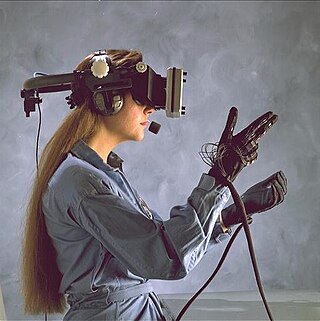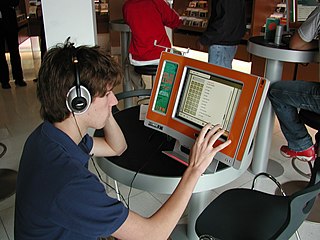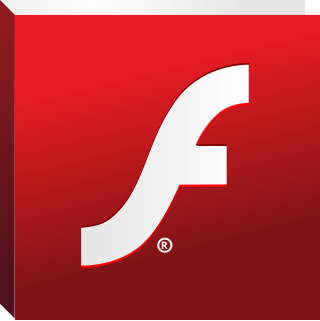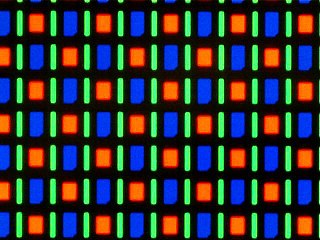Related Research Articles
The GUI, graphical user interface, is a form of user interface that allows users to interact with electronic devices through graphical icons and audio indicator such as primary notation, instead of text-based UIs, typed command labels or text navigation. GUIs were introduced in reaction to the perceived steep learning curve of CLIs, which require commands to be typed on a computer keyboard.

A pointing device is a human interface device that allows a user to input spatial data to a computer. CAD systems and graphical user interfaces (GUI) allow the user to control and provide data to the computer using physical gestures by moving a hand-held mouse or similar device across the surface of the physical desktop and activating switches on the mouse. Movements of the pointing device are echoed on the screen by movements of the pointer and other visual changes. Common gestures are point and click and drag and drop.

A smartphone is a portable computer device that combines mobile telephone and computing functions into one unit. They are distinguished from feature phones by their stronger hardware capabilities and extensive mobile operating systems, which facilitate wider software, internet, and multimedia functionality, alongside core phone functions such as voice calls and text messaging. Smartphones typically contain a number of metal–oxide–semiconductor (MOS) integrated circuit (IC) chips, include various sensors that can be leveraged by pre-included and third-party software, and support wireless communications protocols. More recently, smartphone manufacturers have begun to integrate satellite messaging connectivity and satellite emergency services into devices for use in remote regions, where there is no reliable cellular network.

Haptic technology is technology that can create an experience of touch by applying forces, vibrations, or motions to the user. These technologies can be used to create virtual objects in a computer simulation, to control virtual objects, and to enhance remote control of machines and devices (telerobotics). Haptic devices may incorporate tactile sensors that measure forces exerted by the user on the interface. The word haptic, from the Greek: ἁπτικός (haptikos), means "tactile, pertaining to the sense of touch". Simple haptic devices are common in the form of game controllers, joysticks, and steering wheels.

A touchscreen or touch screen is the assembly of both an input and output ('display') device. The touch panel is normally layered on the top of an electronic visual display of an information processing system. The display is often an LCD, AMOLED or OLED display while the system is usually used in a laptop, tablet, or smartphone. A user can give input or control the information processing system through simple or multi-touch gestures by touching the screen with a special stylus or one or more fingers. Some touchscreens use ordinary or specially coated gloves to work while others may only work using a special stylus or pen. The user can use the touchscreen to react to what is displayed and, if the software allows, to control how it is displayed; for example, zooming to increase the text size.
iRiver, stylized IRIVER and formerly as iriver, is a South Korean consumer electronics division owned by Dreamus which markets music and other accessories in its domestic market.

Cowon Systems, Inc. is a South Korean consumer electronics and software corporation. The company’s initial focus was software development and microelectronics, specializing in speech synthesis and speech recognition technology. In 2000, with the introduction of the iAUDIO CW100, Cowon expanded into the portable media player industry, which is now the core of their business.
Clix, CLIX, etc. may refer to:

A portable media player (PMP) is a portable consumer electronics device capable of storing and playing digital media such as audio, images, and video files. The data is typically stored on a compact disc (CD), Digital Video Disc (DVD), Blu-ray Disc (BD), flash memory, microdrive, or hard drive; most earlier PMPs used physical media, but modern players mostly use flash memory. In contrast, analogue portable audio players play music from non-digital media that use analogue media, such as cassette tapes or vinyl records.

Adobe Flash Lite was a lightweight version of Adobe Flash Player, a software application published by Adobe Systems for viewing Flash content. Flash Lite operates on devices that Flash Player cannot, such as mobile phones and other portable electronic devices like Wii, Chumby and Iriver.
Janus was the codename of a version of Windows Media DRM primarily for portable devices, whose marketing name was Windows Media DRM for Portable Devices. It was introduced by Microsoft in 2004 for use on portable media devices which store and access content offline. Napster To Go was the first online music store to require the Janus technology. Supporting Janus often implies that the device also makes use of Media Transfer Protocol (MTP).

A virtual keyboard is a software component that allows the input of characters without the need for physical keys. The interaction with the virtual keyboard happens mostly via a touchscreen interface, but can also take place in a different form in virtual or augmented reality.

A tablet computer, commonly shortened to tablet, is a mobile device, typically with a mobile operating system and touchscreen display processing circuitry, and a rechargeable battery in a single, thin and flat package. Tablets, being computers, do what other personal computers do, but lack some input/output (I/O) abilities that others have. Modern tablets largely resemble modern smartphones, the only differences being that tablets are relatively larger than smartphones, with screens 7 inches (18 cm) or larger, measured diagonally, and may not support access to a cellular network. Unlike laptops which have traditionally run off operating systems usually designed for desktops, tablets usually run mobile operating systems, alongside smartphones.

The iRiver Clix is a portable media player that was developed and sold by iriver through two generations. The Clix was originally known as the U10, released in 2005. The next year it was revised and essentially rebranded to Clix. A second generation player, often called the Clix 2, was released in 2007, and later a minor revision called Clix+. The players are navigated by four buttons embedded on its sides, referred to as D-Click.
The following comparison of portable media players compares general and technical information for notable digital playback devices.
The iRiver E100 is a portable media player developed by iRiver. It features a 2.4" TFT LCD 320x240 colour screen, built-in 1 watt speakers, a line in port and a microSD card expansion slot up to 8GB. The user interface is navigated by using the iRiver "D*Click" scheme. However, the controls are isolated to the lower section of the device's front. There are minimal buttons located on the side of the device including a power button and two-in-one volume bar. There is also a "hold" switch located on the other side of the device.

AMOLED is a type of OLED display device technology. OLED describes a specific type of thin-film-display technology in which organic compounds form the electroluminescent material, and active matrix refers to the technology behind the addressing of pixels.
The iRiver Story is an e-book reader manufactured and marketed by iRiver and employing a Linux operating system. The iRiver Story HD is a related product with higher display resolution and a display manufactured by LG.
The iRiver Spinn is a portable media player that was developed and sold by iRiver. It was announced at the 2008 Consumer Electronics Show and shipped later that year. It was a successor to the iRiver Clix 2.
The iRiver X20 is a small, flash memory based portable media player (PMP) from iRiver. It was announced at the 2007 Consumer Electronics Show. Initially only 2 and 4 GB versions were announced but soon an 8 GB was also released. It is almost identical to the Insignia NS-DV, a brand from Best Buy.
References
- ↑ "Gadgets: Iriver B20". TheGuardian.com . 19 September 2007.
- ↑ "Mobile-review.com Обзор МР3-плеера и крэдла iRiver U10". mobile-review.com.
- 1 2 "Short Take: iRiver LPlayer". The Technicist.